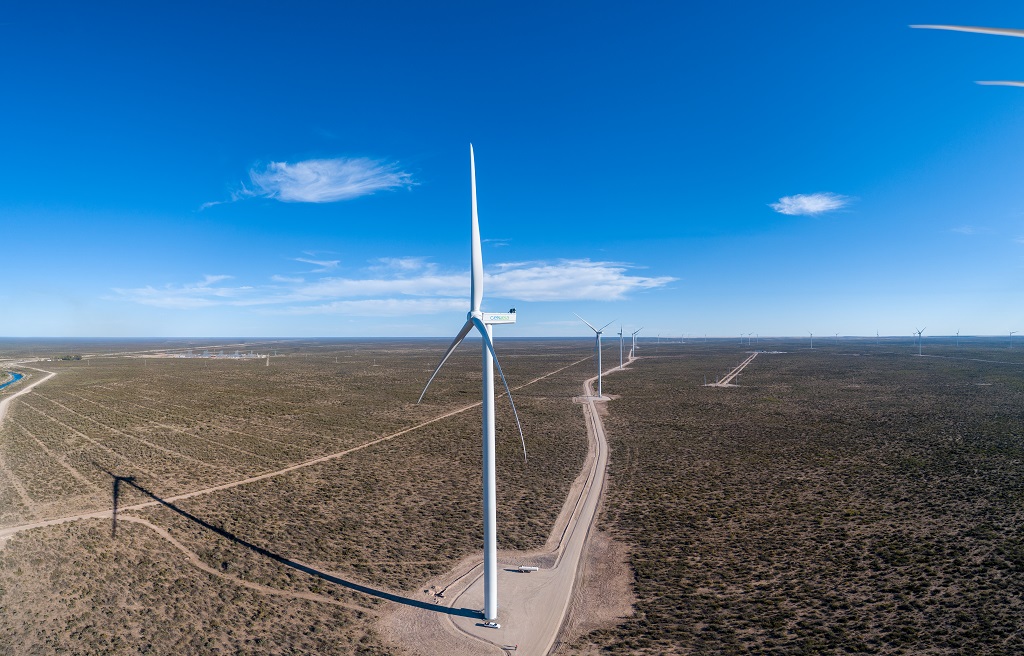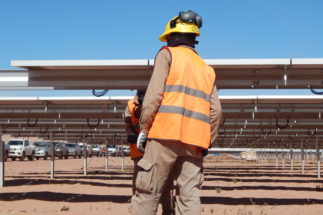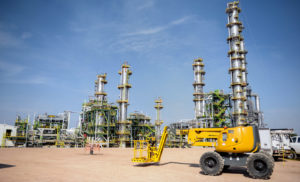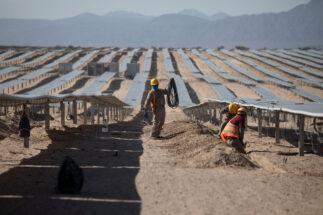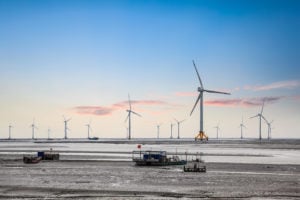As Latin America grapples with the coronavirus pandemic, renewable energy offers a possible pathway to economic recovery and emissions reductions. But many hurdles remain, with governments still betting on fossil fuels and delaying new projects that would boost the clean energy grid.
The region is particularly well-positioned to leverage the renewable industry as a source of new jobs and investment and emissions cuts. Around a quarter of Latin America’s energy supply currently comes from renewable sources, including hydro and bioenergy, but it is not taking full advantage of its vast solar and wind resources.
9.1%
Latin America's expected economic contraction this year
Tapping into those resources could not only alleviate the recession expected in Latin America as a result of the pandemic, with GDP set to drop up to 9.1% this year, but also put the region on a path towards decarbonisation, in line with the Paris Agreement on climate change. This requires reaching net-zero CO2 emissions by 2050.
But to succeed, governments will need to be proactive and set out a green recovery plan focused on the renewable energy sector in Latin America, which hasn’t yet happened. The region has not yet opted for a green stimulus to relieve its economic woes, an idea that has gained traction in other parts of the world.
“Europe and China already set up a road map to tackle the COVID-19 crisis. This hasn’t happened in Latin America. Will we continue giving billions to the fossil fuel sector or instead boost renewables, creating more jobs and helping the economy to recover?” said Ramón Mendez, Uruguay’s former national director of energy and now manager of the IVY consultancy group.
Massive renewable potential in Latin America
While wind and solar capacity is growing rapidly in Latin America, it only represents 6.5% of the region’s current installed energy capacity. Fossil fuels still account for around 75% of the primary energy supply, with the rest of the energy matrix is made up largely of hydropower, biomass and bioenergy.
Countries fall roughtly into two groups based on their electricity mixes. Some rely heavily on hydropower, such as Brazil and Colombia, while others use oil and gas as the primary source for electricity. These include Argentina and Peru. Coal power provides only a small share of total electricity production in most of the region.
Although many rely on hydropower, the potential for expansion is limited by conflicts over land use, forest conservation efforts and indigenous territories. As a result, the share of hydropower is expected to decrease after 2030, making room for solar, wind, and other renewables.
“The potential is huge in terms of the resources. Chile and Mexico have the highest solar radiation levels in the world. There’s also massive wind potential in northern Colombia and southern Argentina. To sum up, there’s enough renewable potential to cover all the demand of the region,” said Lisa Viscidi, head of the energy program at the Inter-American Dialogue.
Over the last two decades, several governments have incentivized renewable energy deployment by implementing technology-specific auctions. Brazil and Uruguay were the first, in 2005 and 2006, respectively, followed by Argentina, Chile and Mexico.
They are all betting on fossil fuels to get more income. But it’s a short-term vision, as oil’s peak demand is right around the corner
Since 2015, clean energy contracts exceeding US$46.8 billion and 32GW of new installed capacity have been awarded through government-led auctions across the region. Some 27GW of this corresponds to non-conventional renewable energy, according to a report by the Inter-American Development Bank (IADB) and Inter-American Dialogue, a think-tank.
But this could be just the start. It is technically and economically feasible to scale up renewable power in Latin America, experts agree. Under the International Renewable Energy Agency’s scenario of a global energy system consistent with the Paris Agreement, 93% of the region’s electricity would come from renewable energy in 2050.
Such an outcome would not only clean up the energy grid and reduce emissions but also boost the economy. A recent report by the IADB estimates that decarbonisation will bring an additional 100,000 full-time jobs in the renewable energy sector by 2030, compared to projections based on current trends.
“Decarbonisation is a necessary and feasible goal for Latin America and the Caribbean that could bring lots of benefits,” said Graham Watkins, head of climate change at the IADB. “All the countries of the region could create more jobs than the ones that would be destroyed as part of the transition to a decarbonised economy.”
Leaders of the pack
Countries without their own natural gas and oil resources have taken the most significant steps in their energy transitions so far. Uruguay now has 98% carbon-free electricity generation, of which wind accounts for 26%, one of the highest shares in the world. At times, its power matrix is almost entirely fueled by wind energy.
Uruguay’s rapid uptake of renewable power generation, especially wind energy, was motivated by years of dependence on hydroelectric dams, backed by oil-fired thermal generation, which was subject to price risk and fully dependent on imports. The country appealed to foreign investors and created 50,000 jobs in the renewable sector.
Costa Rica has similar numbers. The small island nation gets more than 98% of its electricity from renewable energy sources, mainly divided between hydropower and wind. The country was the first in the region to present a comprehensive plan to become a zero-emissions economy by 2050.
“Uruguay and Costa Rica successfully carried out an energy transition but this hasn’t been followed by many other countries. Chile remains as one of the few exceptions,” said Mendez. “Fossil fuels are still much present and this isn’t a good sign. The region is going against the goals of the Paris Agreement.”
Chile, almost without oil and gas but with a lot of coal, which accounts for 40% of the power mix, recently joined Uruguay and Costa in committing to become carbon neutral by 2050, pledging to phase out all coal power generation plants by 2040. It will close the eight oldest plants by 2024.
The country went from having a 3% installed capacity of non-conventional renewable energy in 2014 to 25% today, taking advantage of the solar radiation in the north of the country and the strong winds in the southern Patagonia region. It has already met its goal of having 20% of renewables by 2025.
“We have a sufficient amount of energy supplied by renewable energy that enables closing up the coal plants,” said Andrés Rebolledo, a former Chilean energy minister. “But this has to come with technological advances such as better batteries in order to avoid the variability of renewable energy sources.”
Challenges ahead
Lockdown measures triggered by the pandemic have caused energy demand to drop across the globe and Latin America hasn’t been the exception. This has further challenged the development of renewables, with Brazil, Perú and Mexico slamming the breaks on new solar and wind auctions scheduled for this year.
But the pandemic has also shown many governments are still willing to bet on fossil fuels, allocating more funds to the sector instead of implementing a green stimulus. Argentina decided to subsidise the domestic barrel of oil and grant more resources to natural gas. Last year, fossil fuel companies received 27.6 billion pesos (US$423 million).
The Alberto Fernández administration, which took office in December, hasn’t yet rolled out any policies for the renewable energy sector. The country has an installed capacity of 8% non-conventional renewable sources, with the goal of reaching 20% by 2025, which local energy experts don’t see as feasible given exisiting programmes.
50%
the planned share of renewables in Mexico's energy mix by 2050
Meanwhile, Mexico has a similar trajectory. It has a goal of 35% renewables by 2024, to be increased to 40% by 2035 and 50% by 2050, all of which seem unlikely. Despite the promising auctions launched in 2015, President Andres Manuel López Obrador has canceled new tenders and turned back to fossil fuels.
“It’s a problem shared by oil and gas exporting countries in the region. They are all betting on fossil fuels to get more income. But it’s a short-term vision, as oil’s peak demand is right around the corner,” said Leonardo Stanley, an economist at Argentina’s Center for the Study of State and Society (CEDES). “They lack a strategic vision for their energy sector.”
Latin America has some intrinsic energy problems to resolve. Most renewable resources in Latin America are in areas far away from the urban demand centres.This requires very expensive transmission lines, which are already operating at their capacity across the region and have to be expanded further.
Countries also lack strong, local renewables manufacturing industries and supplies have to be largely imported, mainly from China. Brazil remains the only exception. Finance also represents another barrier to some countries such as Argentina, with existing projects cancelled amid an economic crisis. But Viscidi is optimistic that new funds will materialise.
“The more countries can expand their transmission lines the more possibilities they would have in renewable energy. Investment should keep growing in the coming years,” Viscidi argues.
